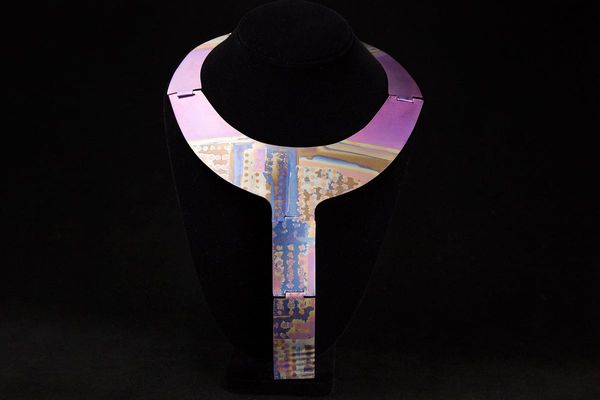
“Reality is a trance. Your reality is a trance of your own making. Or someone else’s making who doesn’t have your greatest good in mind.”
The words are spoken by a woman wearing a white turban and dark jacket over a flowing white robe, sitting next to a glass of water perched on a metal table. So begins Breath of Fire, a documentary about Katie Griggs, aka Guru Jagat.
The film tells how Griggs went from YouTube astrologer to yoga master, spiritual guru and wellness girlboss with followers including celebrities such as Russell Brand, Kate Hudson and Alicia Keys. She had a business school, podcast, festival and two clothing lines and was chief executive of seven international companies.
But as journalist Hayley Phelan puts it in Breath of Fire, “I never understood why there weren’t more questions about a white woman in a turban.” Griggs was also a would-be cult leader who bullied staff, practised cultural appropriation and embraced conspiracy theories such as QAnon before her unexpected death at the age of 41. She has been called “the Elizabeth Holmes of yoga”.
The four-part docuseries, which began last week on HBO, is a smartly edited collage of 35mm films, VHS footage from the 1980s and videos mined from TikTok and Instagram. This is combined with new interviews with those who fell under Griggs’s spell as they sought community, rituals and spiritual fulfillment outside established religion.
This aspect struck a chord with the film’s directors, Hayley Pappas and Smiley Stevens, themselves millennials with an interest in spirituality. Pappas, 34, says via Zoom from Los Angeles: “So much of it spoke to a shared sentiment that we could feel and our peers could feel. This sense of seeking and looking for spirituality in less conventional places, particularly as these traditional religious institutions have lost their influence with our peers.”
Griggs was born on a Colorado farm in the summer of 1979. She was raised by a single mother, a dance movement therapist who exposed Griggs to different forms of spirituality, from tarot cards to Tibetan prayer flags. Pappas says: “Katie was raised around a lot of fascinating conversations and discussions around self-transformation and exploration of the psyche and spirituality.”
Griggs dropped out of university in her early 20s but went on to earn a degree from Antioch College in Ohio. She looked for answers outside the old religions and found them in kundalini, a form of yoga that involves intense breath work, repetitive poses and wearing all white to expand the aura by exactly 1ft, as well as abstention from recreational drugs and alcohol.
Kundalini was popularised in America by Harbhajan Singh Khalsa, a customs inspector at the Delhi airport who, having got a woman pregnant, fled India for the US in the late 1960s. In classic American fashion, he had a blank canvas on which to reinvent himself and make his fortune.
Styling himself as Yogi Bhajan, he claimed that kundalini was an ancient form of yoga long kept secret; in reality he made it up himself. Bhajan gained a grassroots following, built ashrams all over America and helped create 17 businesses. He was accused of rape and sexual abuse by several dozen of his female followers, as well as child abuse and widespread fraud. An investigation carried out after his death in 2004 found the allegations to be credible.
Yet Griggs presented herself as his spiritual heir and staunch defender; to some, his unlikely reincarnation. She claimed that Bhajan gave her the name Guru Jagat. She founded the Ra Ma Institute, turning a kundalini yoga studio into a multimillion-dollar commercial empire. She combined mastery of social media with charisma, humour and a brand of Cardi B-style feminism that resonated with millennial women.
Stevens, 36, reflects: “We had to watch lots and lots of footage of her teaching and we were like, we could actually hang out with this person. We actually thought she’s super charismatic and would make funny jokes all the time too. That definitely helped her in her ascent.”
Griggs was also adept at marketing and branding her Ra Ma studio. “They did a really good job of delivering something that spoke to millennials and had great graphic design and cool colours and funny videos. She was on TikTok and she was on Instagram and she was doing all of the things that actually spoke to millennials. She was intentional about her marketing and did quite a good job of that.”
Pappas adds: “She leveraged social media in an intentional and effective way. She brought spirituality, particularly kundalini, into the social media landscape and she also tapped into a feminist ideology and sentiment.
“She converged with girlboss culture and she embodied and became the girlboss, if you will, of the spiritual circles in a lot of ways. Katie was somebody who was always looking for her own stage and this was the stage where she found her audience and she found what she would say her calling.”
Griggs wore white flowing clothes and wrapped her hair in a turban in what critics saw as a blatant attempt to adopt the trappings of the Sikh religion and imbue herself with faux-spirituality. Sundeep Morrison, a Sikh activist and journalist, says in the film: “As a Sikh it was alarming and it was heartbreaking seeing our scriptures, our prayers used as decoration. And even the article of faith of the turban is seen as a sacred symbol and for to her to wear it with her hair sticking out is bastardising the article of faith.”
Other interviewees have mixed feelings, recalling how they came to regard Griggs as a friend yet how she could also be abusive to them. “They could still access what it was that drew them to her, what it was that kept them there so long and the good parts of her that they did enjoy.
“And at the same time, they were very aware of and angry about her various wrongdoings and the way that she treated individuals and who she ultimately became in the end. It was particularly messy because of how drastically she evolved over those years.”
Griggs fell for QAnon and other far-right conspiracy theories. She questioned the existence of Covid-19 and refused to be vaccinated. She also presided over a toxic atmosphere at her company
Phelan, who interviewed Griggs and is among the talking heads in the documentary, wrote in Vanity Fair magazine in 2021: “Jagat could be abusive, irrational, and was prone to lying; she spent money like water and often came up short when it was time to pay her employees – many of whom, despite being full-time staffers with ‘director’ in their titles, made far below minimum wage and were asked to file as independent contractors, depriving them of benefits like health care.
“In a company-wide group chat, Jagat wrote, ‘Fuck you all’ for not drafting a promotional email as she’d wished and threatened another group: ‘I will ring [sic] your figurative necks if not every photo youve ever taken up until now isnt in the dropbox.’”
Pappas says: “She was taking advantage of people’s various vulnerabilities. She was, as a spiritual teacher, learning a lot of sensitive information about these people but then when they misstepped, when they did wrong in her eyes, she would use that against them in front of others in public.
“A lot of behaviour if she was in squarely one box, as a spiritual teacher or as a boss or as a colleague, perhaps would have been a little bit more understandable or you could make sense of it, but where it became so complicated was that she was filling all of these roles simultaneously for these people.”
It is hard to resist parallels with Holmes, the young entrepreneur whose startup company promised to revolutionise blood testing, only to be eventually indicted and jailed on charges involving defrauding investors and deceiving patients and doctors.
Pappas comments: “You can draw a clear line in comparison to their ambition. You can draw a pretty clear comparison to both their rapid ascent and to everybody’s gleefulness to cheer them on while they were on that rise. At the same time as and when they made mistakes and they showed their human flaws, perhaps an outsized reaction to those.
“Not to dismiss or excuse any of their behaviour, but one of the things that felt important to us was to make it clear that, when looking at Guru Jagat and Yogi Bhajan, we’re talking about two very different people and two very different extents of harm. Guru Jagat’s wrongdoings pale in comparison to those of Yogi Bhajan and his abuses, and in some ways – and perhaps the Elizabeth Holmes comparison – comes with a bit of the female double standard that we see for women who rise to power in this way.”
Griggs’s business and personal health both went into decline. Pappas says: “The walls are caving in on her with comments that she’s made publicly. As this self-proclaimed feminist, she winds up defending a man who has been accused and now been proven to have sexually assaulted and abused many women of various ages. Her mom said she joined the dark side.”
Griggs died in 2021 of cardiac arrest, caused by a pulmonary embolism following surgery on her left ankle, and was buried at the Hollywood Forever Cemetery. The Vanity Fair article told how speaker after speaker took to the podium to eulogise her as a “tantric soul”, “a privileged soul”, an “incredibly brilliant light”, divine healer, and the “mother of creation culture”. Her community has since undergone a reckoning and Ra Ma recently closed down its Los Angeles studio, though it continues in New York and Mallorca.
Pappas hopes that, in a time of social media disinformation, the film will encourage some healthy scepticism and critical inquiry about the multibillion-dollar wellness industry. “I hope that people can see a bit of themselves in these characters and relate a bit to these stories, as extreme as they can seem and as much as I think it’s easy to hear a ‘cult story’ and think that could never happen to me or ‘that’s insane.’
“What we wanted to do is portray our characters as relatable and their desires and their longings as relatable and understanding and show how slippery that slope is and show where that exploitation takes place. That is why we chose to go in through Guru Jagat. Her evolution from Katie Griggs, this well-intentioned seeker, to Guru Jagat, this particularly manipulative guru, felt fascinating and emblematic of this world – and what can be so devastating about it.”
Breath of Fire airs on HBO and streams on Max in the US with a UK date to be announced







